Hydrangea paniculata Phantom - a detailed description of the variety
In 1789, the English scientist Joseph Banks brought the hydrangea to Europe from China. The plant immediately won the love of gardeners, the best breeders of France undertook to breed new species. This is how the Phantom hydrangea appeared, which became popular in Russia. Due to its frost resistance, the variety is grown even in the Far East.
- Description of the variety
- Landing features
- Seat selection
- Preparation of planting material
- Landing technology
- Care
- Watering
- Top dressing
- Mulching and loosening the soil
- Pruning
- Preparing for winter
- Reproduction
- Cuttings
- Layers
- By dividing the bush
- Root shoots
- Seeds
- Diseases and pests
- Use in landscape design
- Testimonials
- Useful videos
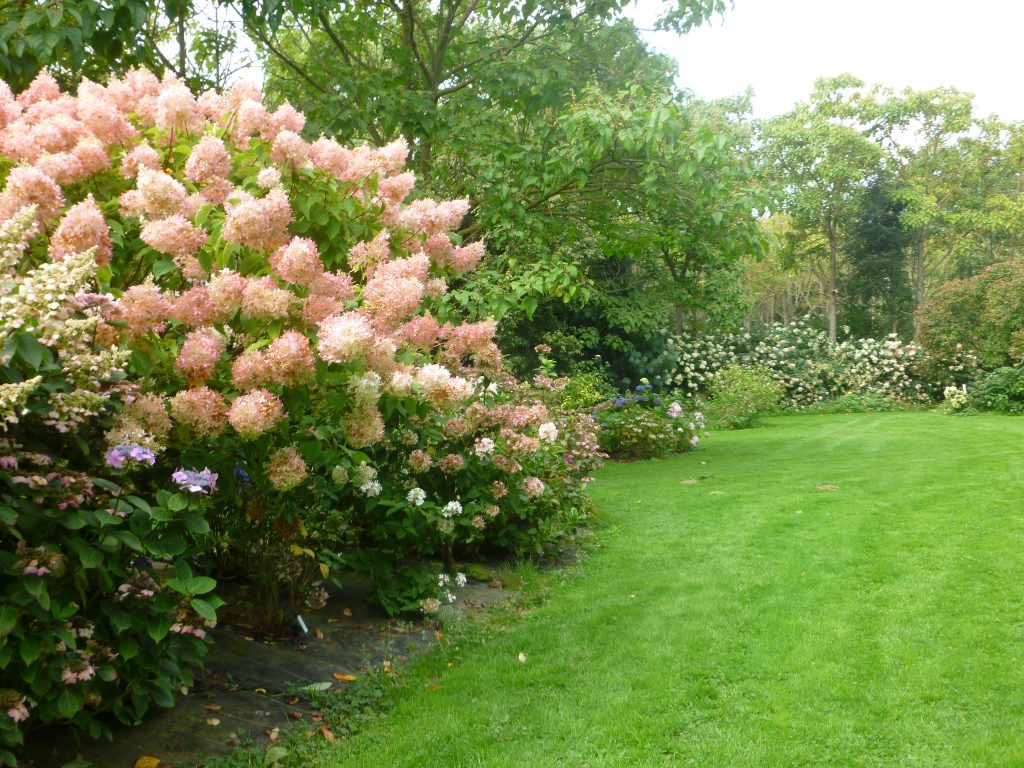
Phantom hydrangea
Description of the variety
Panicle hydrangea Phantom grows in the form of a large shrub - more than 2.5 m in height and the same in width. Stems are strong, thick, brownish brown, capable of supporting the weight of massive flower clusters. Despite their impressive size, the branches do not droop, they are always directed straight up.
The leaves are large, dark green, pointed at the ends. The edges are covered with small teeth, the surface is rough. Over the season, the colors gradually change from green to yellow-brown.
Inflorescences are large, pyramidal, up to 50 cm in length. The flowers are tightly pressed together, but the top looks a little loose. The color of the buds changes over time. In spring they are white, then gradually turn pink.
It begins to bloom at the age of 5 years, and then every year it releases buds for 40 years or more. Flowering is abundant and long - from July to mid-October. Hydrangea smells good. The aroma intensifies in the evening hours.
The Phantom variety is frost-resistant. Even young seedlings do not need shelter for the winter, and adult plants can easily tolerate temperatures as low as -35 ° C. Even in the event of frostbite in the spring, the hydrangea will recover, letting out new shoots from the root. In the northern regions, it is better to cover if the frosts are -35 ° C and above last more than 2-3 weeks.
Landing features
It is better to plant hydrangea in the ground in the spring, before the sap flow begins. Over the summer, it will strengthen, the root system will develop to a state that can survive the winter. Shoots planted in autumn often die even with good cover. They simply do not have enough strength to withstand both transplanting and wintering.
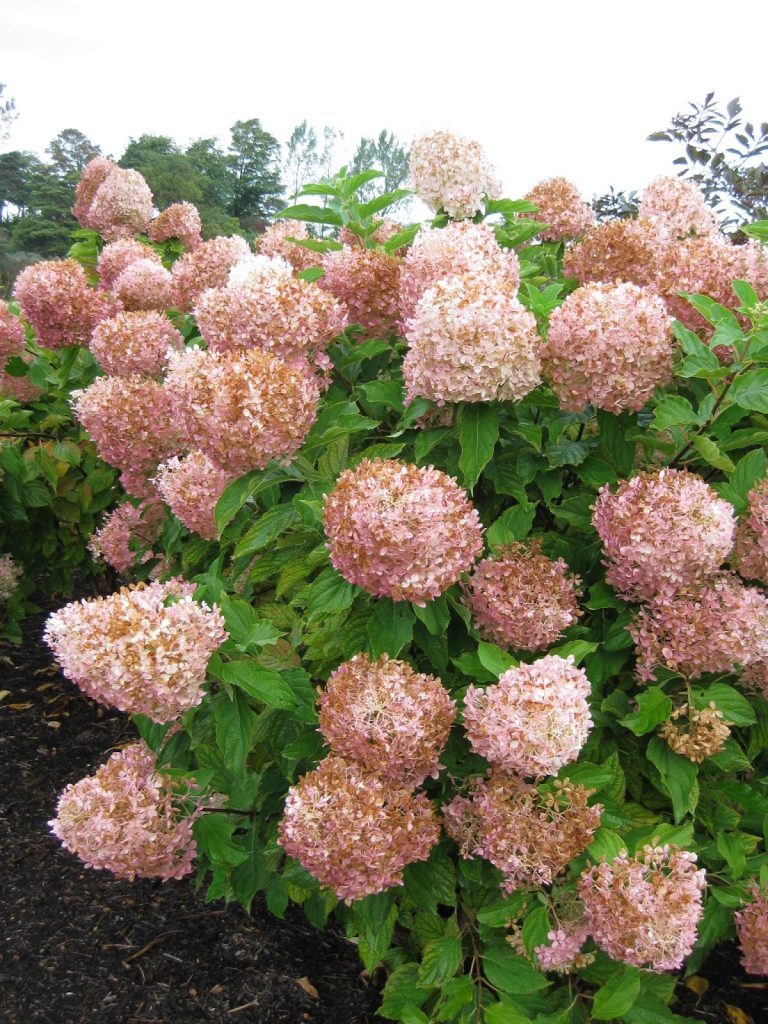
Hydrangea phantom description and photo
Seat selection
Phantom variety is suitable for growing in open, light areas. The crown, like the root system, is very branched, wide, so it cannot be planted close to the wall of a house or other structure. In addition, the shadow will interfere, the flowering will be uneven, one-sided, not so long.
The pit must be prepared in advance, even in the fall, so that a seedling can be placed there immediately after the snow melts. The dimensions of the pit are 80x80x60, even larger is possible. Drainage is laid at the bottom - red brick, stones, crushed stone, large expanded clay. Then poured nutrient soil, mixed with leafy soil, humus, peat and coarse sand.
Hydrangea does not tolerate acidic soils. If the acidity of the soil is increased, then before planting the soil must be mixed with dolomite flour or lime.The site should be level or slightly raised, not a low ground in which water will stagnate. The cultivar will not grow well if the roots are constantly humid. And it is much more difficult to hibernate in waterlogged soil.
Preparation of planting material
Rooted cuttings or young seedlings should be carefully examined.
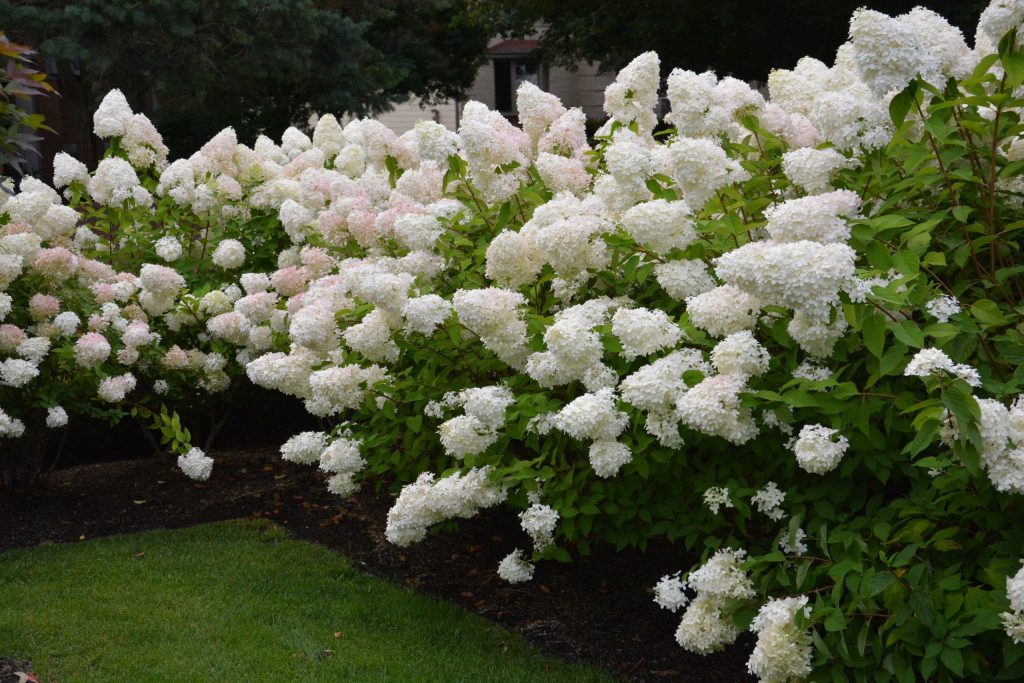
Hydrangea phantom photo and description
A healthy green seedling, with an even bark, without outgrowths and bumps, cracks and chips. The buds are alive, swollen, the roots are dense, without plaque and putrid odor. If the white part is exposed when you run your fingernail along the surface of the root, the roots are healthy.
If the seedling was sent by mail, then during the journey it managed to lose some of the moisture from the branches and roots. It must be placed in water or Ecosil solution for 6-10 hours.
Homemade cuttings, bred on their own, can not be soaked before planting, but spray the roots with a solution of the fungicide Fitosporin or ordinary potassium permanganate.
Landing technology
The seedling is placed in a hole, the roots are gently straightened and gradually covered with earth. Holding the trunk, shake it periodically so that the earth is evenly distributed between the roots. After filling the hole, the root collar should be flush with the ground. You cannot sprinkle it, otherwise it will not survive.
A bucket of water is poured under the root, then a little more soil is added after it has settled. For a start, you need to take water that is settled, warm, preferably rainwater (you can use melted snow).
If properly planted, the seedling will take root in 3 weeks. Then new young leaves will begin to grow. From now on, he was looked after like any other horticultural crop.
Care
The Phantom variety does not require too much care. The first time after planting, they pay a little more attention, an adult seedling adapts to almost any conditions.
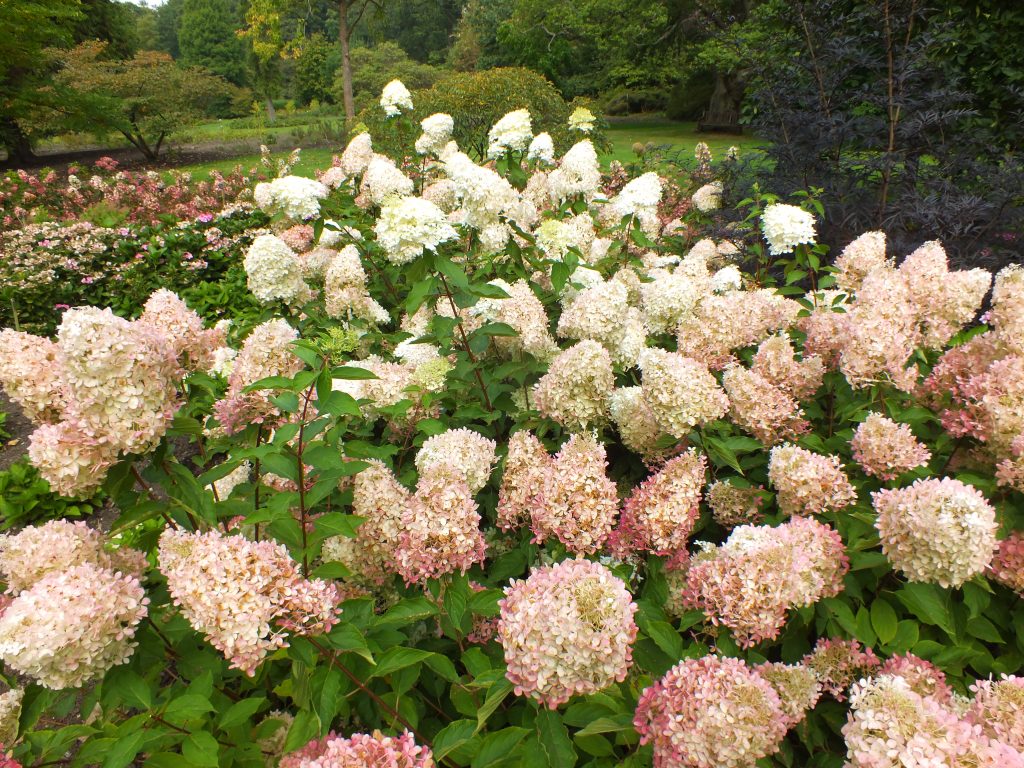
Phantom hydrangea paniculata
Watering
The main mistake gardeners make in caring for young hydrangea seedlings is overflow.
It is optimal to water every 10-12 days. Even in summer, it easily tolerates a dry period without rain, but excess moisture can be destructive.
Young seedlings are watered with settled water in a bucket under a bush:
- In summer - every 10-12 days;
- The rest of the time - once every two weeks.
An adult bush requires at least 20 liters of water at a time.
Top dressing
In early spring, the hydrangea must be fed with nitrogen for a faster awakening from winter sleep and the start of active growth of green mass. It is better to feed the bush into this:
- Ammonium nitrate - 35% pure nitrogen
- Ammonium sulfate - 21% nitrogen, 24% sulfur
- Urea - 46% nitrogen
- Calcium nitrate - 12% nitrogen, 19% calcium. Calcium improves nitrogen absorption.
In summer, phosphorus and potassium are required for bud formation. During this period, the bush can be fed with drugs such as:
- Nitrofoska - you can dig granules around the bush or dissolve them in water and water the plant;
- Nitroammofoska is a complex phosphorus-potassium fertilizer, applied before flowering;
- Diammofoska - 26% phosphorus and potassium, 6% nitrogen. It also contains zinc, sulfur, iron, magnesium.
- AVA - does not contain nitrogen, easily absorbed by plant roots. It is widely used in the West in the care of flowering garden crops.
In autumn, Phantom hydrangea is fed with manure and other organic matter. There is a ready-made complex fertilizer "Autumn", which contains all the substances necessary for the plant.
Many amateur gardeners consider the infusion of nettle to be the best way for the growth and long flowering of the bush.
Nettle is cut, chopped and put into any container (you can use a regular bucket). Then it is poured over with water and left in a warm place to ferment for a week. The ready-made infusion is poured under the root of the bush once a month from May to September.
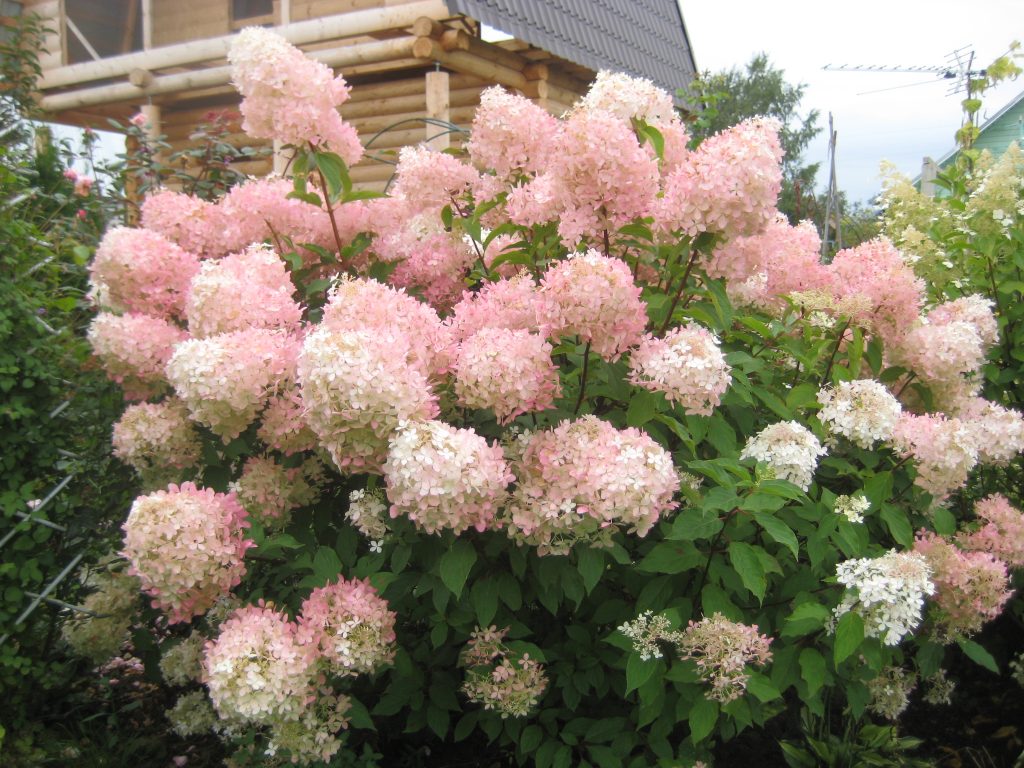
Hydrangea paniculata phantom
Mulching and loosening the soil
The hydrangea root system is superficial, requiring protection from heat and drying out. For the first time, mulch the soil under the newly planted bush with dry compost or humus.Later during the summer, chopped wood and peat are poured into the trunk circle.
Interesting! Mulch keeps moisture well, protects roots from overheating. Annuals planted under a hydrangea bush can also cope with this task. Low-growing phlox, marigolds or calendula are great. It is impossible to mulch the ground with sawdust, especially coniferous (resin).
The soil near the bush must be periodically loosened. The roots are close to the surface and like to breathe. But loosening must be done carefully so as not to damage the small roots. After each heavy rain, you need to go out into the garden with a hand rake and stir the ground under the hydrangea bushes to give them air access.
Pruning
The Phantom variety is very fast growing and dense, without pruning its crown becomes so dense that it does not form buds. Hydrangea stops blooming and starts to hurt. She gradually runs wild, loses varietal properties, but it is not worth bringing to this. It is better to periodically rejuvenate the plant.
Hydrangea is cut twice a year - in autumn and spring. In October-November, before the first frost, all damaged, deformed shoots are removed. It is also better not to leave the branches growing inward. Shoots that have grown over the summer are also shortened, branches with outdated peduncles are removed.
In the spring it will become clear which branches have not overwintered, have frozen. They are cut out so as not to interfere with the growth of the rest. Only clean, disinfected tools should be used for trimming. Remove branches at an angle of 450.
Preparing for winter
In the fall, it is necessary to cut off all the leaves from the hydrangea, except for the upper ones, and sprinkle the ground at the roots with dry peat. Top dressing is stopped, watering is minimized. In this season, there is already enough rains, a lot of moisture comes to the roots. It is important that pruning has already been carried out by winter. It is not recommended to cover before that.
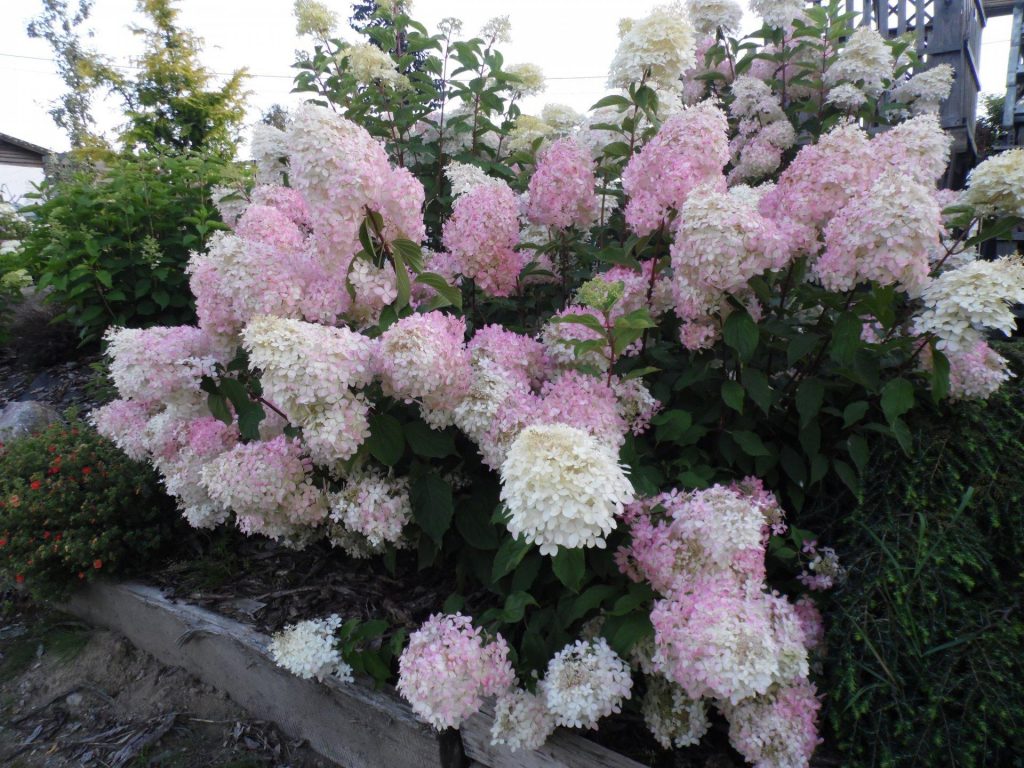
Hydrangea phantom paniculata
The Phantom variety is thermophilic, therefore, during severe winters, it is better to cover it. There are several ways to protect hydrangeas from frost:
- Take a board the same length as the branches, hammer nails into it around the perimeter and put it on the ground. Bend the branches carefully and tie them to the board. Top with spruce branches or dry leaves, and then spongbond. Attach the fabric around the edges with bricks. Cover the entire structure with foil.
- Wrap the bush in a standing position with sponbond. Build a frame around from a metal lattice 10-15 cm higher than the plant, sketch dry leaves inside, cover with a film on top.
- Spread the spruce branches under the branches, bend the branches to the ground in a circle, fix with metal brackets. Put spruce branches on top again and cover everything together with sponbond. The last layer will be peat and dry sawdust. Cover the entire shelter with foil.
Bending the branches to the ground, you need to put bags with leaves under them so that they do not break. Under a layer of insulation and snow, there is a risk of shoots breaking off. It is also better to lay a film on top so that water does not penetrate inside and does not freeze afterwards. This can kill the plant.
Reproduction
Hydrangea is easy to propagate in several ways at once. Some of them are simple, some are only available under certain conditions and require experience.
Cuttings
Cuttings are best cut in the summer, choosing young, spring shoots. Several cuttings are obtained from one branch. Each of them should have 3-4 buds. Cuttings are rooted in a light substrate in a flowerpot or a special greenhouse on the site.
Rooting in summer at an air temperature of + 22-25 ° C takes 2-3 weeks.
From the flowerpot, the cuttings are transplanted into the garden in the fall, they are left in the greenhouse until next year.
Layers
Adult plants from 5 years old are suitable for reproduction by this method. In the spring, the side branches are taken away, bent to the ground and dug into the ground. To prevent the branch from moving, it is pressed down with a stone. The point of contact with the ground is often watered. Within a month, rooting takes place.
It is allowed to separate the layers in autumn, but it is better to keep them "in a bundle" until next summer.By overwintering next to the main bush, the shoot will have a better chance of strengthening and growing to an adult state. After a year, its root system is already strong enough to feed a new young plant on its own.
By dividing the bush
In early spring, a dense plant is subjected to a division procedure. The side part is chopped off with a shovel and planted in a new place according to all the rules. If the bush is not yet too large, it is easier to dig it up entirely, divide it into parts, each of which will have a separate growth point. Thus, the plant will be rejuvenated and will grow and bloom better.
Root shoots
Adult hydrangeas often produce basal processes in the near-stem circle. In the spring, you just need to separate them from the main plant and plant them. The shoots must be removed in any case, even if the task is not to propagate the hydrangea. The sprouts draw on a lot of energy and nutrients. The plant weakens, blooms worse and eventually runs wild.
If the task is to preserve the growth, then it is better to dig it up in the spring or summer. Then the seedling is transferred to a small greenhouse, in which the plant will gain strength until next year. It is believed that the basal shoots do not preserve the varietal properties of the mother bush, but numerous examples show that this is not the case.
Seeds
Hydrangea seed germination is not very high. Before planting, they should be kept in growth biostimulants (Epin, Ecosil) for several hours. Then nutrient soil is laid out in small containers. It should consist of peat, sand, forest land and humus.
Seeds are sown in containers, preferably one per cup, so as not to plant the sprouts later. Delicate seedlings do not tolerate picking well. The seeds are not buried in the soil, just pressed a little, then irrigated with a spray bottle and covered with a film. For better germination, it is worth placing glasses under the lamp.
The sprouts will appear in 2 weeks. They grow rapidly, releasing a leaf per week. After 2-3 months, young seedlings are fully formed. By the end of summer, they are transplanted into open ground. The ideal option is to put them in a greenhouse and keep them there until next year. Then young plants will have a better chance of survival.
Diseases and pests
The main reason for the development of diseases is improper care - waterlogging, lack of pruning, overfeeding with organic fertilizers.
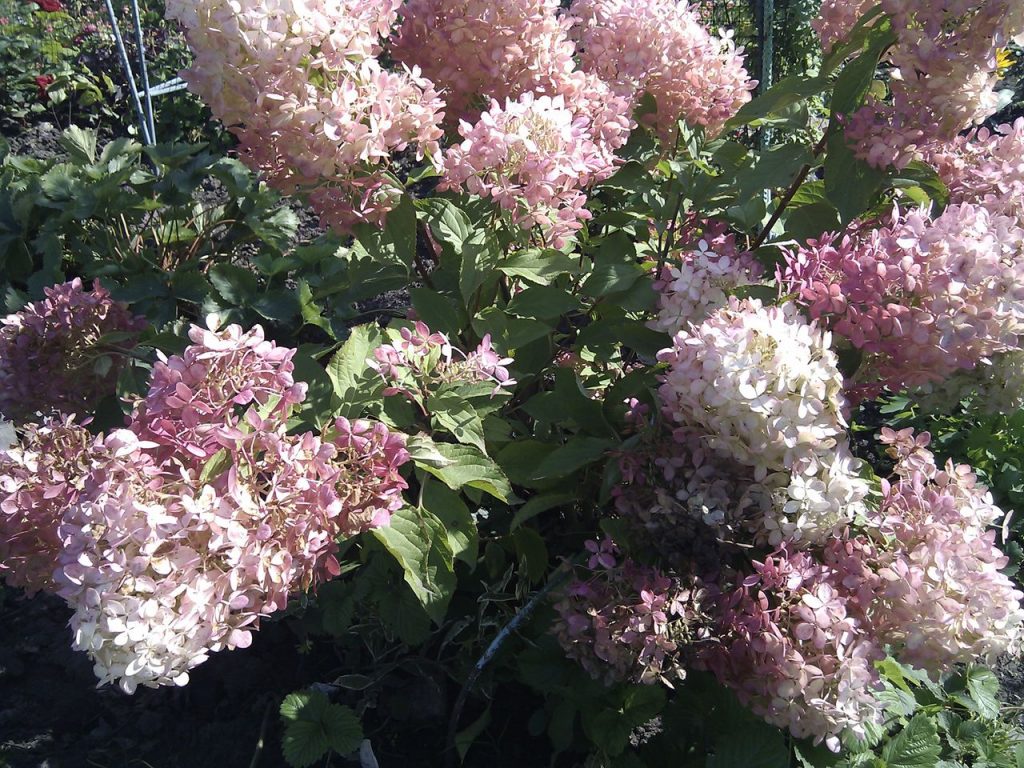
Panicle hydrangea phantom
- Chlorosis. At the first symptoms, treat with Ferovit, Antichlorosis;
- Gray rot. Remove affected leaves and branches, spray with a solution of laundry soap;
- Rust. Treat with copper oxychloride;
- Septoria. Remove affected leaves and branches, treat with Bordeaux liquid.
The bush is often affected by pests:
- Spider mite. Insects are washed off with water, the plant and the soil under it are sprayed with the Anti-mite preparation. The treatment is repeated twice with an interval of 10-12 days;
- Aphid. The insects are washed off, the branches are sprayed with a solution of digester soap or Biotlin.
- Slugs. A bait is laid around the trunk, with which the pests are then collected by hand. Sprinkle crushed lime and eggshells under the branches.
Use in landscape design
Phantom is suitable for growing as a hedge. The bush lends itself easily to crown modeling, it is easy to give it a different shape. From such bizarre forms, they create compositions in the garden. The panicle hydrangea is combined with other hybrids for an unusual cascading flowering effect.
This variety is grown on a trunk right on the balcony. For this, the plant is constantly modeled and shaped, not allowing it to grow. For the winter, if the balcony is not glazed, it is better to remove the flowerpot in the house. Freezing from all sides, it will not protect the roots in winter, the plant may die. If the container is on an insulated loggia, it is not mono to take it into the house for the winter.
Testimonials
Hydrangea is liked by all lovers of ornamental shrubs.It is unpretentious, blooms for a long time and magnificently, it is distinguished by exceptional decorativeness and aroma of inflorescences. It is easy to propagate in several ways, it is resistant to freezing.
There are many positive reviews regarding the winter hardiness of the variety. It is grown in the most northern regions, even without a complex shelter. In this case, the plant always survives, in extreme cases, when the branches freeze, it grows back from the root.
The phantom will become a real gem of any garden. It is unpretentious and very beautiful, abundant and long-lasting flowering. Growing a variety does not require huge efforts, and the result will certainly delight gardeners.

